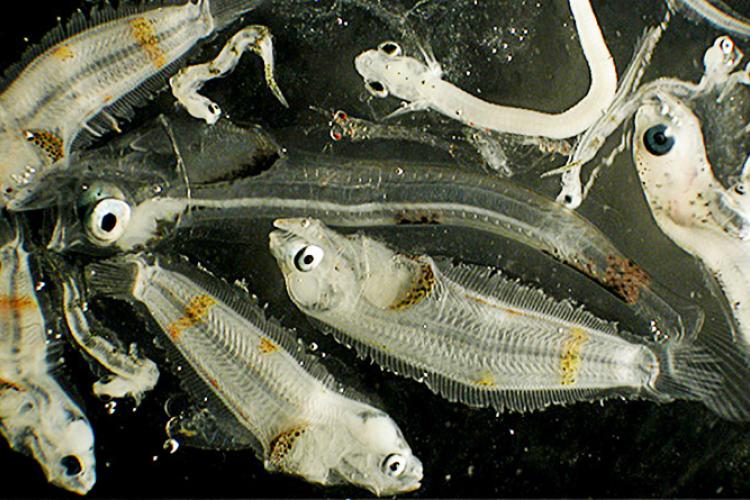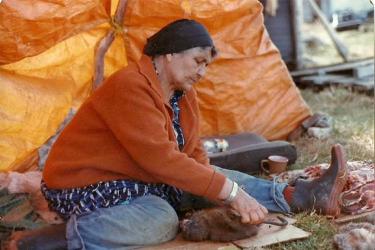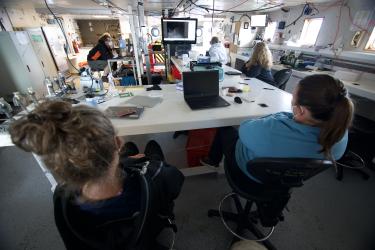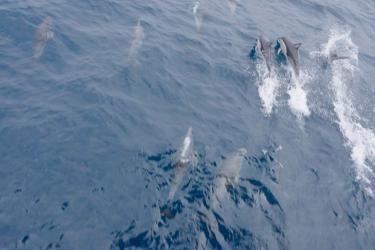We’re conducting an “ichthyoplankton” survey in the region between the Shumagin Islands and Shelikof Strait in Alaska. Ichthyoplankton are fish eggs and larvae that are found mainly in the upper 200 meters of the water column. During this survey we will assess the abundance of a variety of species of Alaskan fish, but especially larval walleye pollock. We will also work to identify the environmental factors influencing their growth and survival such as water temperature, pH and food availability. We’ve been conducting this survey every year for 25 years. Data are used to help determine the number of new fish that are produced each year.
Here is a look at what each of the members of our scientific team do in the lab and while at sea to support this research.
I’m Annette Dougherty a Research Oceanographer with the Alaska Fisheries Science Center. My primary job is to work on larval and age-0 walleye pollock to determine their ages from the daily increments deposited on the otoliths or ear bones. This is sort of like reading the rings on a tree to determine its age. Using the age data, we calculate the time range of when the fish hatched (hatch date = haul date - age). These data are used to determine when and where pollock hatched and how fast they grow throughout their first year of life.
At-sea, I will be the Chief Scientist leading our group in the larval survey aboard the NOAA Ship Oscar Dyson from May 5 - 25, 2019. We will sample for larval fish as well as zooplankton (food for the larvae) to determine the general health and productivity of the ecosystem. All of the data collected on this survey will be used to guide future management decisions.
Steve Porter is a Research Oceanographer with the Alaska Fisheries Science Center. His main area of research examines how changes in the environment affect the growth and survival of walleye pollock larvae. He uses laboratory experiments and field collected data to try to answer these questions. At-sea, he will be identifying species of larval fish and counting them to get an estimate of their distribution and abundance. He will also be collecting walleye pollock larvae to estimate the number of healthy and unhealthy individuals. With this information and environmental data, we can learn about larval survival in the Gulf of Alaska in 2019.
Another Research Oceanographer for the Center is Colleen Harpold. Colleen studies the plants (i.e., phytoplankton) and small animals and immature stages of larger animals (i.e., zooplankton) that form the basis of marine food webs in the Gulf of Alaska and the Bering Sea. Zooplankton are food for the larval and juvenile fish later in the season. She analyzes the chlorophyll samples derived from the phytoplankton collected at-sea and manages the zooplankton database. At-sea, her primary function will be to conduct the Rapid Zooplankton Assessment (RZA) during the night shift. The RZA is a quick sort and identification of the zooplankton community. She will also be helping to collect larval fish and plankton samples for more in-depth analyses back at the lab, and to collect water samples and micro-zooplankton – animals that are between 20 and 200 µm in size.
Jesse Lamb is a Research Fisheries Biologist for the Center. Jesse manages the EcoFOCI zooplankton archive. He also ensures that the collection of animals for scientific purposes (voucher specimens) follows required guidelines to ensure the ethical treatment of the animals. Jesse performs diet analysis on age-0 walleye pollock and Pacific cod in the lab. At-sea, he will be assisting in zooplankton net sampling and conducting rapid assessments of the zooplankton community.
We are also fortunate to have Hillary Thalmann with us this summer. Hillary is a Master’s student and research fish biologist from Oregon State University - Hatfield Marine Science Center. Hillary is working on her thesis research looking at the effects of thermal variability on growth and foraging of juvenile Pacific cod in the Gulf of Alaska. In the laboratory, she has been analyzing juvenile otoliths to collect age and growth data. While at-sea, she will be helping with sample collections. She will also be helping to collect and identify larval fish. She hopes to use some of the Pacific cod larvae we collect to assess the growth of the larvae in warm vs. cold years.
Meet the Bloggers




